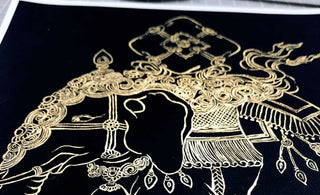
Introduction:
Mandalas, intricate and symbolic geometric patterns, have captivated the artistic imagination for centuries. In recent years, there has been a resurgence of interest in mandalas, particularly in the context of tattoo art and other visual expressions. This comprehensive guide delves into the multifaceted aspects of mastering mandala creation, exploring the history, symbolism, design principles, artistic techniques, and contemporary applications of this mesmerizing art form.
I. Understanding the History and Symbolism of Mandalas:
To truly master the creation of mandalas, it is crucial to grasp their historical and cultural significance. Mandalas have roots in various spiritual and cultural traditions, including Hinduism and Buddhism, where they are used as tools for meditation and representations of the universe. Understanding the symbolism embedded in mandalas, such as the circle representing wholeness and unity, lays the foundation for creating designs that carry depth and meaning.
II. Exploring Design Principles in Mandala Creation:
The art of crafting mesmerizing mandalas requires a solid understanding of design principles. This section explores the fundamental elements of mandala design, such as symmetry, balance, and intricacy. We'll delve into the importance of a central focal point, radial symmetry, and the delicate interplay of shapes and patterns. Examples from historical mandalas and contemporary creations will illustrate how these principles can be applied effectively.
III. Artistic Techniques for Mandala Creation:
Mastering mandala creation involves honing specific artistic techniques. This section explores various methods, from traditional hand-drawing to digital tools. Techniques such as dotwork, linework, and shading play a crucial role in creating the mesmerizing details that define exceptional mandalas. Additionally, we'll delve into the use of color, exploring how it can enhance the visual impact and emotional resonance of mandalas.
IV. Contemporary Applications of Mandala Art:
As mandalas have gained popularity beyond their traditional cultural contexts, this section explores their contemporary applications. We'll examine how mandalas are integrated into different art forms, such as tattoo art, digital illustrations, and even therapeutic practices like mandala coloring books. The adaptability of mandalas in various contexts speaks to their timeless appeal and versatility as a form of artistic expression.
V. Practical Tips and Exercises for Aspiring Mandala Artists:
To master the art of crafting mesmerizing mandalas, aspiring artists need practical guidance. This section provides tips on overcoming common challenges, refining skills, and finding one's unique style. Additionally, it includes hands-on exercises that allow artists to apply the knowledge gained throughout the guide, fostering a hands-on approach to learning and creating mandalas.
Tips for Aspiring Mandala Artists
Embarking on the journey of creating mandalas can be both exciting and challenging. To overcome common hurdles, aspiring artists should start with a solid foundation. Begin by selecting quality materials, such as fine-line pens and smooth paper, to enhance precision. Experiment with different shapes and sizes before diving into intricate designs. One common challenge is achieving symmetry. Utilize tools like compasses or guidelines to maintain balance in your mandalas. Remember, symmetry is not just about perfect circles but creating a harmonious flow within the design. Explore various symmetry techniques, such as radial symmetry or reflective symmetry, to find what resonates with your artistic vision.
Refining Skills and Developing a Unique Style
Refining mandala-making skills involves a continuous process of exploration and experimentation. To enhance precision, practice drawing straight lines and consistent curves. Consider breaking down complex mandalas into individual components and practicing each element separately. This allows you to master specific patterns and later integrate them seamlessly into your complete mandala designs. As you progress, focus on developing your own unique style. Look to diverse cultural influences, such as Indian kolams or Tibetan sand mandalas, for inspiration. Notice the intricate details, the use of symbolism, and the play of symmetry in these traditional mandalas. Incorporate these elements into your creations while adding a personal touch that reflects your artistic identity.
Hands-On Exercises for Skill Application
To solidify the concepts discussed, engage in hands-on exercises that put your knowledge into action. Start with a basic exercise in symmetry – draw a simple mandala with repeated patterns, ensuring that each section mirrors the other. As you gain confidence, advance to more complex designs, experimenting with different geometric shapes and embellishments. Another beneficial exercise involves exploring the use of color. Select a limited color palette and observe how it influences the mood and energy of your mandala. This exercise not only hones your color theory skills but also adds a dynamic element to your creations. Additionally, try incorporating natural elements into your mandalas, such as flowers, leaves, or animals, to infuse symbolic meaning and storytelling into your art. Remember, the key is to enjoy the process and embrace imperfections as part of the creative journey.
Mastering the art of mandala creation requires a blend of practical tips, continuous skill refinement, and personal exploration. Overcoming challenges, refining techniques, and developing a unique style are essential components of this artistic journey. By engaging in hands-on exercises that apply these principles, aspiring mandala artists can not only enhance their skills but also cultivate a deep connection with the meditative and expressive qualities inherent in the art of mandala-making. As you embark on this creative adventure, let your imagination soar, and may each mandala you create be a reflection of your unique artistic spirit.
Conclusion:
In conclusion, mastering mandala creation is a journey that involves delving into history, understanding symbolism, applying design principles, honing artistic techniques, exploring contemporary applications, and engaging in practical exercises. By unlocking the secrets of crafting mesmerizing mandalas, artists can not only create visually stunning pieces but also tap into the spiritual and cultural richness that makes mandalas a timeless and revered art form.
























